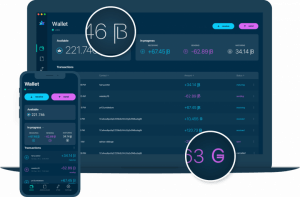As the first Mimblewimble implementation to go live, Beam bills itself as a scalable and confidential privacy coin which aims to give its users fuller control over personal data at no expense of performance.

What is Beam?
Launched in early January 2019, Beam cryptocurrency is yet another representative of what a “new wave” of coins implementing Mimblewimble protocol as their main shtick. Together with the launch of its Grin which took place only a few days apart, Beam is a part of the effort to improve what its creators see as the shortcomings of the existing privacy coins such as Monero (XMR), Zcash (ZEC) and others:
- Stronger control over one’s privacy. The Beam’s competitors are seen as defining privacy as a model which does not make transactions private by default. In other words, users of these currencies users have to turn on privacy features if they do not want to see their transactions treated as public. With Beam, however, all transactions are treated as private by default, instead of being offered as an “option”. In words of the team behind the project, the users will be the only party capable of determining “which information will be available and to which parties, having complete control over his personal data in accordance to his will and applicable laws.”
- Privacy can be paired with the confidentiality model as an added value. The Beam introduces the concept of both confidential transactions (more on that below) and confidential assets. Its innate mechanisms support creation of multiple asset types, such as new currencies, real estate tokens, corporate debts etc., which can be subsequently exchanged with the help of the Beam platform.
- Beam will offer advanced scalability based on keeping its blockchain compact and lean. In addition to privacy, Beam aims to address the issue of scalability in order to secure the longevity of its “cryptoverse”. Transactions taking place with Beam are not supposed to create bloating of the blockchain. Its Mimblewimble protocol allows for the pruning of the old data which are considered irrelevant for the processing of the current transactions. This is supposed to reduce the computational overhead demands and improve the system’s overall scalability.
- Transactions with Beam should be both versatile in scope and easily auditable. Beam uses “Scriptless Script” technology which provides support for integrating various transaction types beyond the scope of those focused on mere transfers of value. Based on this, Beam will support escrow, atomic swaps and time-locked transactions. While the focus on privacy remains the prime directive for Beam, the system still aims to play by the rules when it comes to regulations: Beam supports the integration of unforgeable digital signatures with its wallet. Upon demand, the authorized auditors can be given permission to check the full list of transactions, together with the attached documentation relevant to them.
- Broader accessibility. The Beam team believes that technological excellence should not impair accessibility if their solution is to gain mainstream adoption over time. To this end, they designed wallets for desktops and mobile devices, whose dashboard design reflects the focus on daily use by individual and business users alike.
What Are the Components of Beam Platform?
The launch of Beam’s mainnet meant the public release of the following components:
- Desktop wallet app (with CPU miner node)
- CLI (command line interface) wallet
- Beam node
- Stand-alone OpenCL and Cuda miners
In addition to these, Beam coin (BEAM) serves as the officially designated cryptocurrency of the project.
Immediately after the release, the Beam team promised that 2019 will see its members working on additional components of the Beam ecosystem:
- Pool support
- Atomic Swap with BTC mobile wallet
- Payment platforms integration (API)
- Integrated bitcoin wallet
How Does Beam Implement Mimblewimble Protocol?
The Beam team’s promise of creating a coin combining privacy and scalability at no expense of one another largely rests on its successful implementation of the Mimblewimble protocol. The protocol itself was named after a “Tongue-Tying Curse” spell used in the fictional Harry Potter universe. In August 2016, a cryptographer using the pseudonym of “Tom Elvis Jedusor” (the French name of the character Voldemort, in yet another reference to Harry Potter’s world) published an early version of the Mimblewimble whitepaper.
The vision promoted by one “Jedusor” now lives on in two projects – Grin and Beam, which both implement their interpretations of it. With its initial focus on turning Bitcoin’s alleged “pseudonymity” into true anonymity, Mimblewimble’s goals were found to be largely in line with what Beam aimed to achieve by relying mainly on its two key features:

What Are Confidential Transactions?
Confidential transactions implemented with the help of the Mimblewimble utilize the Pedersen Commitment scheme that offers its “hiding” and “blinding” features with the help of Elliptic Curve Cryptography. This allows Beam users to blind or hide any information on the amount which is relevant to the transaction they are engaged in. With this approach, only parties to the transaction (sender and receiver) know the amount of funds which are being transacted with, with no access allowed to the prying eyes of potential onlookers.
To achieve this, Mimblewimble implements ‘blinding factors’ which encrypt the amount of cryptocurrency the users want to send. The factors do this by assigning a random value by which the real amounts in a transaction are multiplied. This is followed by a creation of single multisignature which is supposed to “cover” for all inputs and outputs in a single transaction.
In turn, the recipient of a transaction randomly selects several of the blinding factors provided by the sender. The receiver can subsequently use these factors as proof of ownership which authorizes them to spend the coins. There is also a public multisignature key which is used for transaction verification, with only senders and receivers being “in the know” about their activities which are treated as being part of their shared secret scheme.
How Does Beam Aim to Protect Personal Data?
Unlike what is found in other blockchains, Beam aims to get rid of the system based on using addresses which are recorded in the blockchain and used to as a proof of ownership of the coins. With Beam, the UTXO ownership can be sufficiently confirmed by checking the value and the blinding factors only. The only thing kept in the blockchain is the commitment which becomes relevant once the wallets are prepared to engage in transaction.
In addition to removing personal information from the blockchain structure, each address on Beam has a regular expiration interval of 24 hours which is subject to changes through the wallet interface. Beam creators recommend their users to create new receiving address for each transaction.
Beam’s push for better privacy protection with blockchain prompted it to implement the Dandelion Protocol as well. This solution has also found its place on other coin platforms such as Zcoin, based on its capacity to lower the probability of “linkability” to personal data, such as those relating to addresses and transactions. While Dandelion found its place in Grin as well, the Beam creators claim that only their platform supports adding decoy dummy inputs and outputs.
Finally, Beam also implements the Secure Bulletin Board System (SBBS) which makes it possible for the wallets to exchange encrypted messages in a secure manner without the requirement to be online at the same time.
How Does Beam’s CoinJoin Work?
With the Beam’s implementation of the Mimblewimble protocol, the aim is broaden the scope of changes beyond traditional address-based model to include signatures and private and public keys as well. Beam wants to get rid of all of them, preferring to stick to inputs and outputs only. They play a key role in Beam’s implementation of yet another technological trump card in form of CoinJoin technology.
Originally proposed by Bitcoin Core contributor Gregory Maxwell, CoinJoin is an anonymization strategy which combines the following features:
- With CoinJoin, multiple transactions are merged, with all senders recorded as sending funds to all receivers.
- This system will allow for obfuscation of inputs i.e. the addresses from which the payments are made to the other addresses playing the role of outputs.
- By creating a mixture of transactions in this manner, Beam can support its claim to offer better privacy since it effectively prevents the outside parties from identifying which specific payment went to an individual party.
- Yet, privacy enforced in this manner should not allow the Beam users to grow a magic coin tree on their blockchain. Beam’s confidential transaction systems runs on homomorphic encryption – it ensures that authorized parties can still check and confirm the validity of transactions made with Beam by correlating the number of inputs and outputs. If the resulting values equal out, the individual transaction can be considered valid, even with the use of “blinded” amounts.

Can Beam Really “Cut Through” the Scalability Issue?
Beam’s implementation of Mimblewimble protocol meant gaining access to its cut-through features which support its effort to deliver better scalability. The whole process works like this:
- As described above, Pedersen commitment scheme allows for the merging of transactions ranging from A to C, allowing it to “cut through” B, as an intermediary.
- Since intermediary outputs which form a single block are presented as a single large transaction, the system can store only the current state without the need to do the same for entire transaction history.
- After a new node becomes a part of the network for the first time, it can start working with compacted history only, i.e. the one containing information on system state and blockchain headers. Since there is no need to retrieve the entire transaction history, this approach is supposed to significantly reduce the amount of information a node needs to start mining or verify new blocks.
How Does Beam Plan to Ensure “Fairer” Mining?
With Beam, blocks are mined using Proof-of-Work paired with Equihash algorithm. Beam developers mention Equihash in the same breath as Mimblewimble, describing it as a stable and GPU-friendly solution aligned with its goal to secure more equitable coin distribution. BEAM hopes to decentralize its network from the outset – this is to be done by discouraging ASIC-based mining over the initial interval of no more than 18 months and allowing BEAM coin mining with GPUs.
While this does not mean leaving ASIC miners in the lurch, the general idea is to provide CPU and GPU miners with a head start in the initial period of the platform’s lifecycle. This approach is also supposed to deliver better hashrate and cryptographic wall for the Beam platform. In order to further incentivize the miners, the first five years of Beam will feature block reward distribution with the ratio of 80% of rewards going to the miners and the remaining 20% being divided between the Beam Foundation, employees, investors, founders and advisers.
BEAM Coin Availability and Competitors
While comparisons with Grin seem inevitable, CEO of the Beam project Alexander Zaidelson, does not treat Grin as a direct competitor, preferring to call it “co-petitor” with which cooperation in certain points is a possible option.
Despite technological similarities, two Mimblewimble cryptocurrencies differ much in their approach to business models. While Grin focuses on keeping the project afloat with the help of community’s donations, Beam started out as a more or less standard startup, with a long-term aim to leave its operations in the hands of its non-profit foundation. While the identity of Grin’s creator(s) remains clouded by the shroud of mystery, Beam’s website has a list of team members who receive salaries and participate in attracting the investors’ money for the project.
Based on this, Beam wants to be a more business-friendly solution among the two, splitting its development efforts into two main directions: BEAM Core, which is focused on technology, and BEAM Compliance which offers opt-in auditability features by which businesses can work on regulatory compliance and cooperate with auditors if necessary.
While other privacy coins such as Monero and Zcash are considered competitors of Beam in areas such as scalability, auditability and confidentiality, the project also emphasizes partnerships, such as the recent one involving Litecoin. Based on it, the Beam team will help Litecoin introduce privacy and fungibility features by assisting them with the implementation of the Mimblewimble protocol.
BEAM coin is available for trading on cryptocurrency exchanges such as Hotbit and BitForex.
